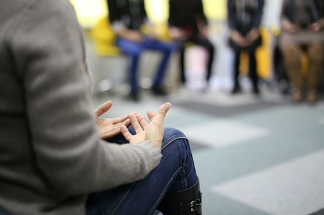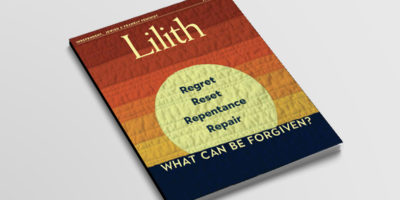
Stopping Judgment in Its Tracks
Time to re-label “bad choices.”
“Addiction followed by redemption” is the familiar trope that implies wrongdoing, even sinfulness, on the part of a person who has used and “abused” what are referred to as “substances.”
Part of my job as a harm-reduction therapist is to help people sort out the shame, guilt, self-punitive impulse and desire for redemption engendered by a culture that sees substance use as moral failure and a society that judges it a crime. In 2016, I was a social work student interested in youth who were aging out of foster care, and slightly disappointed that my first year’s field placement was with a homeless mobile outreach team. I considered homelessness a policy issue beyond the realm of a street outreach crew, and I believed our food and clothing distribution, referrals to services and crisis deescalation work were nowhere near even a bandaid-level treatment for a national wound that requires policy change—not free soup—to heal. But this was during the third wave of the American opioid crisis, when overdose deaths were increasing dramatically thanks to the illicitly manufactured synthetic opioid fentanyl, far more potent than heroin and added to a variety of drugs to decrease production costs and increase profits.
Conducting assessment after assessment with people who did not have housing and who reported long histories of drug use, I realized quickly that there had been a bit of a chicken-and-egg confusion even in the minds of self-identified progressives: for the vast majority of the people I worked with, substance use didn’t cause loss of housing, substances were used because of loss of housing. Substance use didn’t cause trauma, substances were used because of trauma. Substance use didn’t cause economic hardship, substances were used to survive economic hardship. Substance use didn’t cause mental illness, substances were used to manage mental illness. This is not to diminish the real and tragic risks and harms that are involved in drug use, especially in a policy atmosphere of punitive prohibition. But for so many people, drug use is (or at least starts as) functional and helpful. Far too often, though, the laws, policies, practices, beliefs and attitudes that affect the lives of people who use drugs are neither functional nor helpful.
It’s now several years later, and I work in a sunny Brooklyn office with people who are struggling with their substance use and who haven’t found traditional, abstinence-based treatment effective. Many have found such treatment harmful and will not subject themselves to further judgment, shaming and dismissal. After Hours Project is a multi-service agency in Brooklyn that provides, among other things, access to sterile syringes and other materials for safer injection, medication-assisted treatment for opioid use, and mental health services (that’s me!). My office walls are covered in informational posters in Spanish about Hepatitis C, postcards from the LGBT Center welcoming the queer and trans communities, the 2020 HIV Drug Chart and stickers from the Canadian community-based health organization Street Health that affirm: “Drug users deserve safety and support.” A few steps away are stairs that lead to the syringe exchange, where my colleagues give out injection materials and naloxone, the overdose reversal medication. In adjacent offices are HIV case managers and housing specialists. Here we work towards abstinence from substance use, but also towards reduced substance use, better-managed substance use, safer substance use, and sometimes we work only on other areas of life—because people can improve their emotional wellness and work towards their goals without changing anything about their drug use.
I’m happy when the people I work with achieve their goals, but I’m most deeply fulfilled when they achieve redemption not through the renunciation of their “sin” but through the realization that their reasons for using substances are real, important and legitimate…and when they realize that much of their suffering is not because they made a “wrong choice,” but because the world around them has fumbled its response to this choice.
Essentially, this is what harm reduction offers service providers, policy makers, and the public: redemption from the sin of oppressing people who use drugs. Imagine this, for example:
You head over to your local hospital’s inpatient detoxification unit to withdraw from heroin under medical supervision. In detox, you will get medications to safely manage the symptoms of withdrawal that accompany sudden abstinence from heroin use. You’ve left your kids with your mother. You feel slightly guilty about this, but you’ve been increasingly worried about your health, the possibility of overdose, your financial stability, and the legal risks of your drug use. This is your third time in this unit over the last six months—you go whenever your insurance will cover it—and the hospital staff therapists, previously warm and accessible, now don’t approach you to do their phony “assessment” until the day of your discharge.
You overheard a doctor dismissively call you a “frequent flier.” Nobody is talking to you about long-term treatment options anymore. You feel kind of written off. In group, a counselor tells a story about her own recovery: from the “mistake” of drug use to the redemption of “better choices.” “Clean” and “dirty” urines. Substance “abuse.” Substance “misuse.” “Addicts.” You understand yourself to have done something wrong, and you feel bad about it. You are aware of what people think about others who use drugs, and it affects how you understanding yourself. You are urged to avoid “people, places and things” that trigger cravings.
Yeah, sure, you think. I will definitely avoid my closest friends, my neighborhood, the stress that is a part of my daily life, and my romantic partner. You’re taught how to prevent relapse. You know that relapse is a very shameful thing. It’s failure. You’re also told that you have a disease. This is slightly comforting, because it means you’re not entirely to blame, but it’s also disheartening. Also, this idea that your disease means that you can never use a substance again doesn’t ring true. After all, you know people who in the past had a serious problem and now drink, smoke weed, and do some cocaine once in a while. They seem perfectly fine.
A few days later, you don’t feel much more prepared to leave the hospital this time than you did last time. If you’re being honest with yourself. This whole thing has been hard. You don’t feel like you were treated nicely. Plus none of this stuff—the groups, the counseling, the peer support— has been helpful. When you meet with the therapist to do your assessment, you don’t share that you’re dying to get out of here and use again. You don’t want her to judge you, coax you into saying things you don’t mean, or get a desperate, panicky look in her eyes.
You leave the hospital. There’s fentanyl— far stronger than heroin—in the area and it’s caused a few overdoses. It might be in your bag today. You prepared so well for detox, getting rid of all of your injection materials because they are definitely triggers, and now you don’t have a needle. You may have to use someone else’s. You have to really work to find a vein because most of yours are shot. You don’t want anyone to know that you’re doing this just hours after getting discharged from detox, so you’re outside and alone. You could get arrested. You could die out here. Nobody knows you’re here.
This is what happens in traditional, abstinence-based substance use treatment: a puritanical model of substance use reinforces shame, drug use is presumed to be a purely poor choice with only negative outcomes, recovery has a singular meaning of total and permanent abstinence, and people who are not interested in or able to achieve immediate abstinence from substance become neglected—leaving them at risk of overdose, transmission of viral infections, increasingly chaotic use of substances, and other harms. If somebody continues to use drugs, the rhetoric is: “They haven’t hit rock bottom yet. Wait until they do.”
Enter harm reduction. Part social justice movement for the rights and dignity of people who use drugs, part a philosophy- of-life to human problems, and part a set of highly pragmatic and specific evidence-based public health practices, the best-known of which is syringe exchange. It also includes safe injection sites and widespread use of naloxone.
Harm reduction rejects a moral judgment of substance use in favor of a compassionate and functional understanding: People do things for good reasons, even excellent reasons. Sometimes I remind myself of this mantra: All people do all things for excellent reasons. Use drugs for excellent reasons. Have unprotected sex for excellent reasons. Even harm themselves. My rule of thumb is, the more difficult to see the reasons, the better they are. When someone is harming others—when people deplete their partners’ savings, when parents neglect their children (women often bear the brunt of this judgment), when a manual laborer risks the lives of coworkers by being intoxicated at work—making judgments can cloud my understanding. I keep in mind that it doesn’t take a great reason for someone to be 10 minutes late for work or to steal a pack of gum. But if somebody is doing things that are very hard to live with, that hurt the people that they care about most and that lead to chronic guilt and regret, then their reasons must be extraordinarily important.
Harm reduction is curious about these reasons and is interested in respecting people’s self-determination by creating opportunities to reduce risks and harms even if the person is not interested in stopping right now—or ever. The harm reduction pioneer responsible for bringing overdose-reversal medication naloxone to the streets, Dan Bigg, coined the phrase “Any Positive Change” to express harm reduction’s goal.
In practice, and when dealing with clients, this means breaking things down as follows: You didn’t get arrested because you use drugs, you got arrested because drug use is illegal here, which is an injustice. You didn’t lie to your employer because “drug users lie and manipulate,” you lied to your employer because drug use is stigmatized and you don’t want to bear the brunt of this stigma—and you don’t want to be penalized for anything when you’re excellent at your job. Harm reduction says that people who use drugs, like all other people, can be—and routinely are—excellent parents, workers, leaders, friends, and members of society.
In the imaginary situation above, a harm reduction approach would have looked like this:
A staff therapist notices that you have been cycling in and out of detox and asks why. Over the course of your conversation, you’re able for the first time to verbalize what has made this so hard for you: heroin actually helps you out a lot. The staff therapist doesn’t try to convince you that this is a distortion; instead, she validates your reasons for using. She also points out to you how motivated you really are: you’ve come to detox three times in six months! Someone who is not serious about making changes doesn’t do stuff like this. You and she try to strategize around each thing that heroin makes easier, looking for other options. She offers some biomedical options, including methadone and suboxone treatment.
In group, you learn about how “recovery” means different things for different people. You realize that for you, right at this moment, recovery might mean making positive changes that improve your health and your emotional wellbeing, and that decrease some of the financial harm and the legal risks you’ve been experiencing. You don’t know if you want abstinence right now. The group facilitator seems to respect this and seems weirdly enthusiastic about exploring how you might go about reducing your risk of arrest and decreasing the cost of your use.
You also learn about how normal and expected intermittent returns to drug use are. A counselor discusses responsible preparation for these returns to use and urges group members not to fear or deny cravings for drugs, because an impulsive, shame-filled return to use can be very risky. She says explicitly: “You do not deserve to die, contract an illness, get arrested, or feel bad about yourself just because you’re using a drug.” You learn how to prepare emotionally through compassionate self-understanding. You learn how to inject safely: how to rotate veins, how to position the syringe, what materials to use. You learn where in your city you can obtain new, sterile syringes. You learn about preventing and reversing overdose: Never use alone. Try not to mix drugs. Go slow, especially after a period of abstinence—like this one, in detox. You leave with naloxone. You know how to use it. You also have a referral to a local harm reduction organization. You’re even thinking you might start on suboxone. You feel pretty good. You have options. You are proud of yourself. You have done nothing wrong.
So, what do communal atonement and responsibility look like this new Jewish year, as the American opioid crisis persists, as the overdose death rate skyrockets during the Covid-19 pandemic, and as eviction and dislocation lead to public drug use in areas where it previously happened indoors?
Teshuva starts with acknowledgement that in practically all spaces—including in progressive and accepting communities, health care settings, and religious or spiritual centers—people who use drugs are seen as bad people who are deliberately doing harm to themselves and others. Next, we regret our misguided judgments and our collective role in policing, stigmatizing, neglecting and incarcerating people who use drugs. Finally, we make a plan to correct these wrongs in our lives. I started with the simplest affirmation that the lives of people who use drugs matter: getting naloxone, which I keep on me at all times. You could also start by initiating this conversation in your community. Or by learning more about the criminalization of drug use and its role in mass incarceration. Or by exploring with curiosity and openness the messages about drug use that you have internalized throughout your life. Or by learning to see public drug use in your neighborhood not as an aesthetic blight but as a public health crisis involving human beings who deserve privacy, safety, and your compassion.
Rebecca Halff is a social worker and a former Malka Fellow at Lilith.



